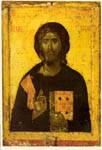|
|
| Portable Icons |
1360-80 Pantokrator Monastery Wood, egg tempera, 104 x 71 cm |
|

|
On the main face of this double-sided icon Christ is depicted as the Pantokrator. He is portrayed from the waist up wearing a cherry-red tunic with a clavus and a deep blue himation. His right hand is raised before his chest in a gesture of blessing, and he holds a richly-bound closed Gospel in his left. The long face is framed by brown hair, which touches the left shoulder. The beard sprouts softly out of the chin and is rendered with sensitive linear brushstrokes. The inscription 'Jesus Christ Pantokrator' is written in the upper part of the icon on a yellow ground that imitates gold. This iconographical type of Christ Pantokrator is a common one in Byzantine art. However, the slender proportions and the long, narrow face bring this icon very close to the Pantokrator in the Hermitage in St Petersburg, which is also from Pantokrator Monastery and dated to about 1363 (Vocotopoulos 1995, no. 96). St Athanasios the Athonite, in bust, is wearing a hooded monk's habit and holding a half-opened blank scroll. The prominent cheekbones, sunken cheeks, relatively small, narrow eyes, and long light brown beard give the saint's ascetic face an intense expression. The ground of the icon is yellow, as on the other side, and the inscription, 'St Athanasios the Athonite', is written on either side of the saint's head. Athanasios's face is rendered with limited areas of dull green underpainting, to which is added the brown colour of the flesh, the prominent areas of the brow and cheeks being emphasised with white, linear highlights. The technique employed for the faces of both figures is typical of Byzantine art from the mid-fourteenth century and after (Xyngopoulos 1956, pp. 16ff. Soteriou 1959, pp. 81ff.). Dense fine hatching accentuates the illuminated areas of the face, giving the luminous flesh a translucent quality, an impression which is strengthened by the shading, which, with no linear outline, defines and softly blends into the face in a painterly manner. In monumental painting, this technique is seen in the frescoes in the Church of the Peribleptos at Mistra (Xyngopoulos 1956, pp. 29-32), the frescoes at Ravanica in Serbia (1385-7), and the frescoes by Manuel Eugenikos at Calendzicha (1384-97) in Georgia (Lazarev 1967, figs. 520-1, 524). The geographical spread of the technique, which served to produce fleshless, idealised figures animated by a religious lyricism and an exalted spirituality, cannot be unconnected with the mystic tendencies that prevailed in religious thought after the triumph of the Hesychast movement and spread throughout the Balkans into Russia in the second half of the fourteenth century. Furthermore, the wide diffusion of this particular technique, with its specific aesthetic effect, confirms that, despite the gradual decline of its political power, Constantinople continued to set the tone of artistic inquiry. More specifically, as regards the type and execution of Christ's face, this icon's close similarities with the Hermitage icon and, particularly, with Christ in the Transfiguration in the Peribleptos at Mistra (Chatzidakis 1974 (1), fig. 13) suggest that it should be dated to the third quarter of the fourteenth century; a dating which may be slightly narrowed down to somewhere between 1360 and 1380. Its high standard of execution makes the icon one of the most representative works of art from this period.
| |
|
Bibliography: Byzantine Art 1964, nos. 201, 721. Weitzmann et al. 1966, p. XXXI, pl. 71. Tsigaridas 1978, pp. 194-5, pl. 13α.
| ||
| E.N.T. | ||
| Index of exhibits of Monastery of Pantokrator 14th century |
||
Reference address : https://www.elpenor.org/athos/en/e218ab20.asp